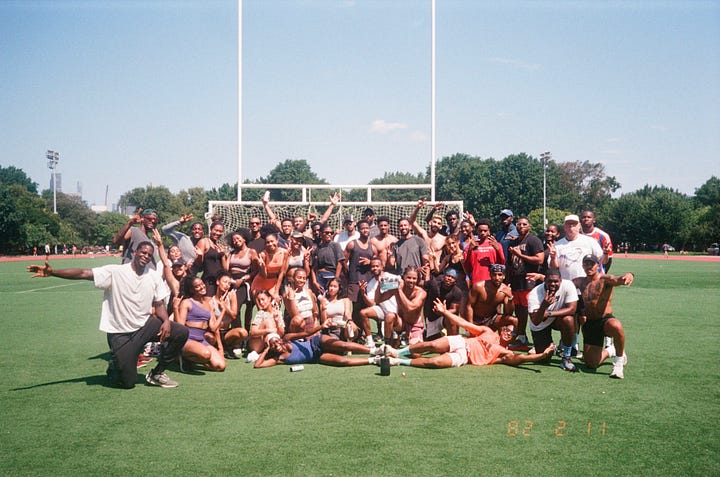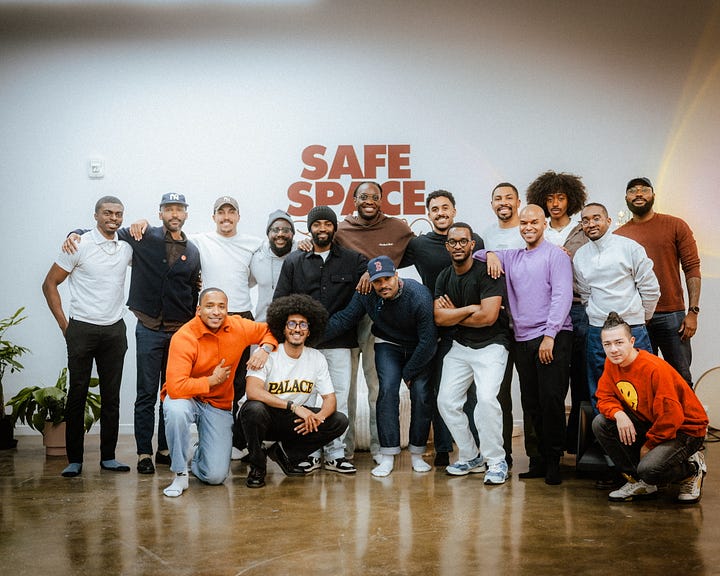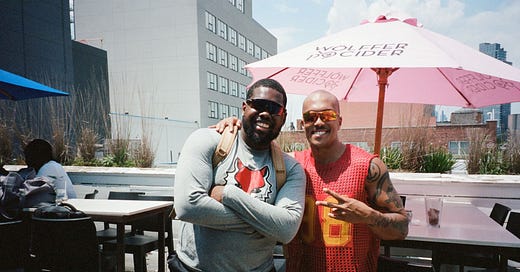Rebuilding the Rhythm of Belonging
When the world shut down, so did the rituals we relied on to feel human.
Post-COVID, cities reopened—but something stayed broken. Nightlife didn’t hit the same. Networking felt transactional. Even friend groups shifted. In cities like New York and Oakland, people were surrounded by millions yet felt disconnected.
A new kind of community began to form. It didn’t start in bars or coworking spaces. It began on the pavement.
Run clubs began to quietly reshape how people found each other again, not as workouts, but as reentry points into a sense of belonging. They offered structure in uncertain times, familiar faces in unfamiliar cities, a place to move your body and meet people who got it, without needing to drink or scroll.
This is especially true for Gen Z, a generation that is more health-conscious, socially aware, and intentional about their energy than previous generations. For them, community isn’t built in the club. It’s built around shared values, consistent habits, and feeling seen.
The new question isn’t “Where are we going out tonight?”
It’s “You running with us this week?”
Why Gen Z Needed Something New
For Gen Z, socializing has never just been about going out—it’s always been about finding in. As the most digitally connected generation, they’ve also been emotionally isolated. And when the pandemic hit, it intensified everything: screen fatigue, anxiety, and the loss of spontaneous connection.
Many people weren’t returning to bars and crowded clubs as the world reopened. Not because they didn’t want to socialize, but because those spaces no longer offered the connection they were looking for.
What Gen Z wanted was:
Intention over impulse
Recovery over escapism
Community over clout
And they started building it themselves.
According to a 2024 report by McKinsey & Company, 56% of Gen Z in the US rank fitness as a top priority, compared to just 40% of the general population. Meanwhile, The Linus Group’s Gen Z Wellness Report found that 72% of Gen Z identify mental health as their primary health and wellness concern.
This isn’t just about physical wellness—it’s about emotional and cultural well-being, too. They’re turning to spaces where you don’t need to perform to participate. You can show up in running shoes, headphones, or just curiosity, and be welcomed into something tangible.
These aren’t just run clubs.
They’re response systems.
To burnout. To trascience. To a nightlife culture that doesn’t align with how Gen Z wants to feel.
The Clubs Rewriting the Playbook
Gen Z is inventing its own spaces, without relying on traditional third spaces, such as bars, churches, and malls. What’s emerging is a new kind of gathering: rooted in movement, driven by culture, and built to last.
These aren’t wellness brands or fitness start-ups.
They’re grassroots, founder-led ecosystems that blur the line between social club, fitness collective, and cultural movement.
Not A Run Club (Brooklyn)




In a city known for constant motion, Not A Run Club (NARC) is slowing things down just enough to make connections intentional again.
Founded by Noah Hutchins and Omari Ross, NARC is a wellness-centered community that started with reclaiming movement as a tool for deeper well-being, not just fitness metrics. What began as BK Run Club has evolved into a multi-faceted, multi-pillar community focused on four dimensions:
Wellness
Fitness
Creative Expression
Social Connection
Their mission is clear: reclaim community through wellness and movement.
At a time when nightlife felt stale and social circles fragmented, NARC offered something different. Weekly runs were only part of the experience. Members could also join creative workshops, mindfulness retreats, yoga sessions, and DJ-led social gatherings across NYC’s boroughs—all designed to nurture physical health and mental and emotional well-being.
NARC now boasts over 2,000 active members, 75+ events with 15-300 attendees, and partnerships with Feed the Streets, MELA, Moss, Lifetime Fitness, and Orange Theory.
And despite the wave of TikToks labeling run clubs the “new dating apps,” co-founder Noah Hutchins remains intentional about NARC’s purpose:
“I don’t have a run club so people can date—it’s more of a health-and-wellness-centered idea.”
—Noah Hutchins, via The New York Times
NARC Presents: Run For Your Buns
Still, there’s an undeniable magic in how NARC creates natural opportunities for connection. Runners aren’t just finding fitness—they’re finding their people.
At its core, NARC understands that movement is just the invitation. Belonging is the goal.
How did you decide to expand NARC beyond running into a full wellness and creative collective?
“The decision to expand NARC beyond running happened organically, like most of the things we’ve done thus far. When you intentionally bring people together in spaces they enjoy being in, it becomes natural to expand into their interests, so that others may also enjoy the experience. It helps that I have been spending the past years exploring different hobbies and activities, so I’m excited about any/every side quest the community wants to do (besides rollercoasters or skydiving). I’m afraid of heights.
What have you learned about the topics people are searching for after the COVID-19 pandemic?
COVID left people in the city hungry for a lot of things. Then factor in the rise of TikTok brain, the future of AI, and macroeconomic downturn… people need people more than ever. Before COVID, I felt it was easier to navigate with a small clique, but now I’m learning the power in numbers and the potential of supporting each other to go farther, faster. NYC is full of transplants, but it’s not only the transplants searching for community structures; it’s born and raised New Yorkers, local businesses, large corporations… everyone’s trying to be or find community these days.
How do you balance being wellness-driven while embracing the fun, social side?
I wouldn’t even consider the need to balance being fun and social with wellness. At least, these are inseparable from the same token. Humans are social beings, and we generally love having fun. Having fun and maintaining social connectivity to your tribe is often more impactful than green juice or your meditation app, cause I rock with them too.
NARC Presents: Skyline Sessions
How do you choose brand partnerships—and what makes one feel authentic vs. transactional?
Brand partnerships have been a journey for us and a reflection of the maturation of how intentionally we have operated. I have no shame in saying that in our early days, any brand partner reaching out felt massively validating and was met with open arms. Now we must understand that not everything matches our brand ethos or our vision for our future. It is more beneficial for us at times to stay in our lane as we are in the process of building and branding what NARC means and feels like to both our community and adjacent audiences. There is no cookie-cutter recipe for who we choose to partner with, but it starts with understanding who we are and letting feelings sometimes drive decision-making. A Safe Space Mentor comes to mind, they immediately filled gaps in our offerings that we felt were imperative to maintaining a healthy community, so we happily will drive our members to engage with them through our collaborative events, and they’re cool people, it feels right.
Where do you see NARC over the next 2-3 years?
NARC over 2-3 years looks like a lot of fun and is cool. We’ll become a catalyst for connection and activating real communities in NYC, and hopefully a few other cities. It’s the first time I’ve gotten to do something that I have seen positively impact many people, so it feels good to drive this. We plan to grow while maintaining the intimacy established, enabling people to connect with folks while moving and being active. Eventually, the communities will be self-sufficient and provide more career and leadership opportunities, as well as more resources to give back and support each other as we build strength in numbers.
NARC Presents: Cross-Pollination
Strategy in Motion — What This Means for Brands
Community is no longer a metric. It’s an infrastructure.
For brands trying to reach Gen Z, these run clubs aren’t just “cool new collabs;” they’re culture in motion. They are the new third spaces, where brand loyalty isn’t bought—it’s earned through presence, alignment, and care.
Gen Z has made one thing clear:
They don’t want to be marketed to.
They want to be built with.
Clubs like Peak & Pace, Town Strides, and Not A Run Club aren’t interested in being backdrops for brand activations. They’re curating real-world experiences that already hold trust, joy, and consistency. That makes them powerful brand partners—if you move with intention.
Strategic Principles for Brands Looking to Show Up:
Partner With People, Not Moments
A one-time activation might feel flashy, but it fades. What these communities value is investment: in time, in talent, in outcomes. Long-term support > quick photo ops.
Add Value, Don’t Extract It
Bring resources, tools, hydration, space, gear, playlists, or recovery. Show up in ways that enhance the experience, not just make it louder.
Expand the Definition of Wellness
Health is not one-size-fits-all. Mental wellness, cultural celebration, joy, and safety are all integral to these communities. If your brand doesn’t understand that, it will feel out of place.
Don’t Lead with Product. Lead with Purpose
The product is a secondary. What wins here is alignment, consistency, and values that match the people in the room (or on the pavement).
These clubs aren’t just community organizers.
They’re cultural curators, wellness architects, and social strategists.
And for the brands bold enough to listen?
They might be your new marketing department.
The Future is Fast — and Intentional
These run clubs aren’t trends.
They’re templates.
They show us what modern connection looks like when built on consistency, safety, and cultural alignment. In the same way, nightlife once shaped the social landscape, offering structure, softness, and space at a time when so many feel stretched thin.
And they’re not slowing down.
From Brooklyn to Oakland, what started as weekly runs has become something much bigger:
Small business partnerships drive local economies
Friendship networks that outpace dating apps
Culturally affirming wellness spaces that move beyond exclusivity
Community infrastructures built not in buildings, but in motion
The future isn’t about speed for speed’s sake. It’s about omentum that matters.
For Gen Z, that means showing up authentically.
Lacing up for yourself and others.
And choosing community, not consumption, as the baseline of connection.
Nightlife might have been about where you go. But this new wave? It’s about where you belong.




